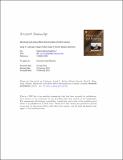Files in this item
Menstrual cycle phase affects discrimination of infant cuteness
Item metadata
| dc.contributor.author | Lobmaier, J.S. | |
| dc.contributor.author | Probst, F. | |
| dc.contributor.author | Perrett, D.I. | |
| dc.contributor.author | Heinrichs, M. | |
| dc.date.accessioned | 2016-02-12T00:12:28Z | |
| dc.date.available | 2016-02-12T00:12:28Z | |
| dc.date.issued | 2015-04 | |
| dc.identifier | 172300535 | |
| dc.identifier | c03953c4-eeda-46e6-88a1-0faac319e985 | |
| dc.identifier | 84923040761 | |
| dc.identifier | 000353746500001 | |
| dc.identifier.citation | Lobmaier , J S , Probst , F , Perrett , D I & Heinrichs , M 2015 , ' Menstrual cycle phase affects discrimination of infant cuteness ' , Hormones and Behavior , vol. 70 , pp. 1-6 . https://doi.org/10.1016/j.yhbeh.2015.02.001 | en |
| dc.identifier.issn | 0018-506X | |
| dc.identifier.other | ORCID: /0000-0002-6025-0939/work/64360987 | |
| dc.identifier.uri | https://hdl.handle.net/10023/8208 | |
| dc.description | This study was supported by the Swiss National Science Foundation (SNF) awarded to JL (grant numbers PZ00P1_121622 and PP00P1_139072). | en |
| dc.description.abstract | Recent studies have shown that women are more sensitive than men to subtle cuteness differences in infant faces. It has been suggested that raised levels in estradiol and progesterone may be responsible for this advantage. We compared young women's sensitivity to computer-manipulated baby faces varying in cuteness. Thirty-six women were tested once during ovulation and once during the luteal phase of their menstrual cycle. In a two alternative forced-choice experiment, participants chose the baby which they thought was cuter (Task 1), younger (Task 2), or the baby that they would prefer to babysit (Task 3). Saliva samples to assess levels of estradiol, progesterone and testosterone were collected at each test session. During ovulation, women were more likely to choose the cuter baby than during the luteal phase, in all three tasks. These results suggest that cuteness discrimination may be driven by cyclic hormonal shifts. However none of the measured hormones were related to increased cuteness sensitivity. We speculate that other hormones than the ones measured here might be responsible for the increased sensitivity to subtle cuteness differences during ovulation. | |
| dc.format.extent | 6 | |
| dc.format.extent | 367037 | |
| dc.language.iso | eng | |
| dc.relation.ispartof | Hormones and Behavior | en |
| dc.subject | Infant cuteness discrimination | en |
| dc.subject | Gonadal steroids | en |
| dc.subject | Kindchenschema | en |
| dc.subject | Menstrual cycle | en |
| dc.subject | Estradiol | en |
| dc.subject | Progesterone | en |
| dc.subject | Testosterone | en |
| dc.subject | Infant–parent bonding | en |
| dc.subject | BF Psychology | en |
| dc.subject | RC0321 Neuroscience. Biological psychiatry. Neuropsychiatry | en |
| dc.subject | NDAS | en |
| dc.subject.lcc | BF | en |
| dc.subject.lcc | RC0321 | en |
| dc.title | Menstrual cycle phase affects discrimination of infant cuteness | en |
| dc.type | Journal article | en |
| dc.contributor.institution | University of St Andrews. School of Psychology and Neuroscience | en |
| dc.contributor.institution | University of St Andrews. Institute of Behavioural and Neural Sciences | en |
| dc.contributor.institution | University of St Andrews. Centre for Social Learning & Cognitive Evolution | en |
| dc.identifier.doi | 10.1016/j.yhbeh.2015.02.001 | |
| dc.description.status | Peer reviewed | en |
| dc.date.embargoedUntil | 2016-02-12 | |
| dc.identifier.url | http://www.sciencedirect.com/science/article/pii/S0018506X15000197#appd001 | en |
This item appears in the following Collection(s)
Items in the St Andrews Research Repository are protected by copyright, with all rights reserved, unless otherwise indicated.

